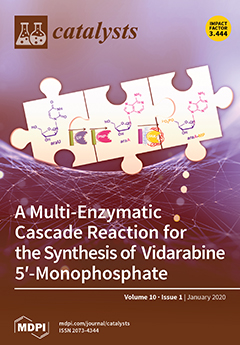The effect of the Pt–Sn/α-Al
2O
3 catalyst reduction method on dehydrogenation of mixed-light paraffins to olefins has been studied in this work. Pt–Sn/α-Al
2O
3 catalysts were prepared by two different methods: (a) liquid phase reduction with NaBH
4 and
[...] Read more.
The effect of the Pt–Sn/α-Al
2O
3 catalyst reduction method on dehydrogenation of mixed-light paraffins to olefins has been studied in this work. Pt–Sn/α-Al
2O
3 catalysts were prepared by two different methods: (a) liquid phase reduction with NaBH
4 and (b) gas phase reduction with hydrogen. The catalytic performance of these two catalysts for dehydrogenation of paraffins was compared. Also, the synergy between the catalyst reduction method and mixed-paraffin feed (against individual paraffin feed) was studied. The catalysts were examined using X-ray diffraction (XRD), scanning electron microscopy (SEM), energy dispersive X-ray spectroscopy (EDS), X-ray photoelectron spectroscopy (XPS), thermogravimetric analysis (TGA), and Brunauer–Emmett–Teller (BET) analysis. The individual and mixed-paraffin feed dehydrogenation experiments were carried out in a packed bed reactor fabricated from Inconel 600, operating at 600 °C and 10 psi pressure. The dehydrogenation products were analyzed using an online gas chromatograph (GC) with flame ionization detector (FID). The total paraffin conversion and olefin selectivity for individual paraffin feed (propane only and butane only) and mixed-paraffin feed were compared. The conversion of propane only feed was found to be 10.7% and 9.9%, with olefin selectivity of 499% and 490% for NaBH
4 and hydrogen reduced catalysts, respectively. The conversion of butane only feed was found to be 24.4% and 23.3%, with olefin selectivity of 405% and 418% for NaBH
4 and hydrogen reduced catalysts, respectively. The conversion of propane and butane during mixed-feed dehydrogenation was measured to be 21.4% and 30.6% for the NaBH
4 reduced catalyst, and 17.2%, 22.4% for the hydrogen reduced catalyst, respectively. The olefin selectivity was 422% and 415% for NaBH
4 and hydrogen reduced catalysts, respectively. The conversions of propane and butane for mixed-paraffin feed were found to be higher when compared with individual paraffin dehydrogenation. The thermogravimetric studies of used catalysts under oxygen atmosphere showed that the amount of coke deposited during mixed-paraffin feed is less compared with individual paraffin feed for both catalysts. The study showed NaBH
4 as a simple and promising alternative reduction method for the synthesis of Pt–Sn/Al
2O
3 catalyst for paraffin dehydrogenation. Further, the studies revealed that mixed-paraffin feed dehydrogenation gave higher conversions without significantly affecting olefin selectivity.
Full article





